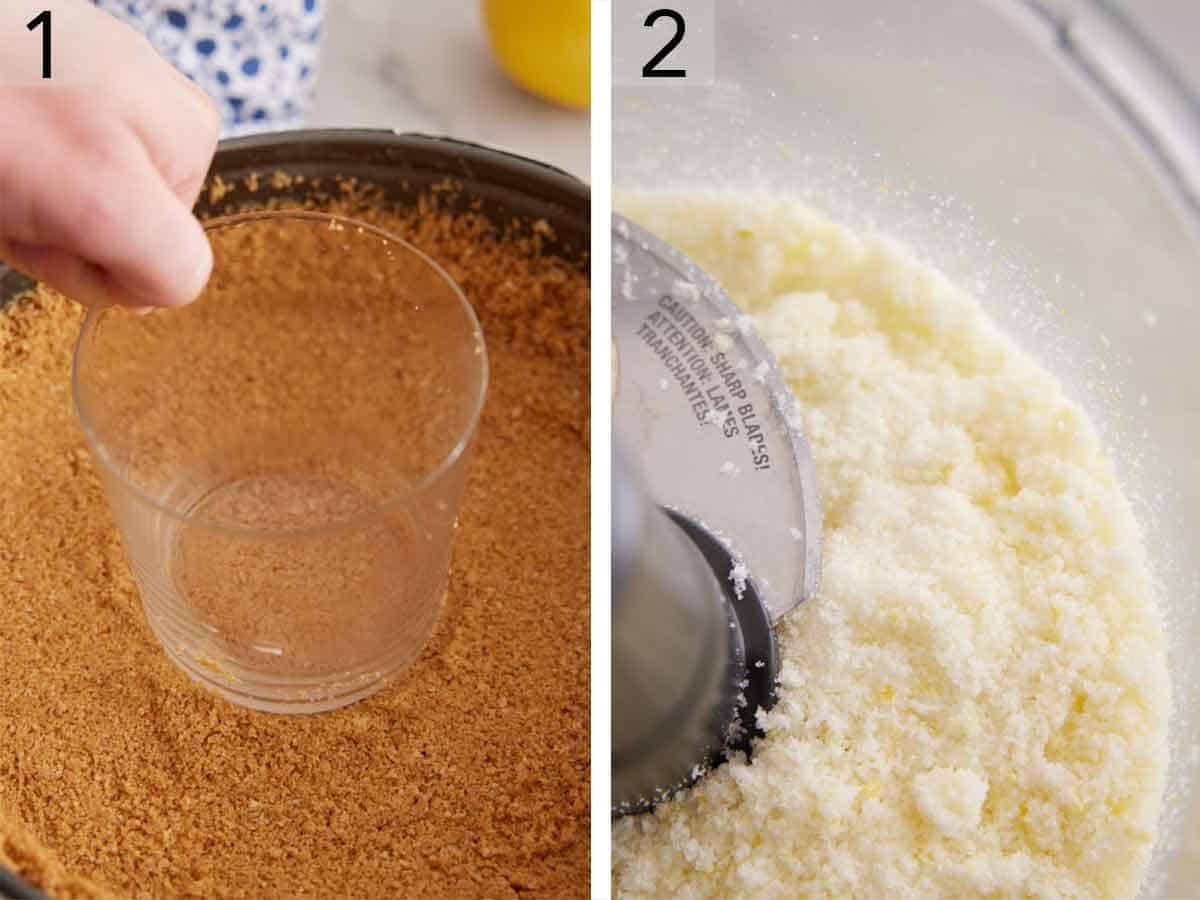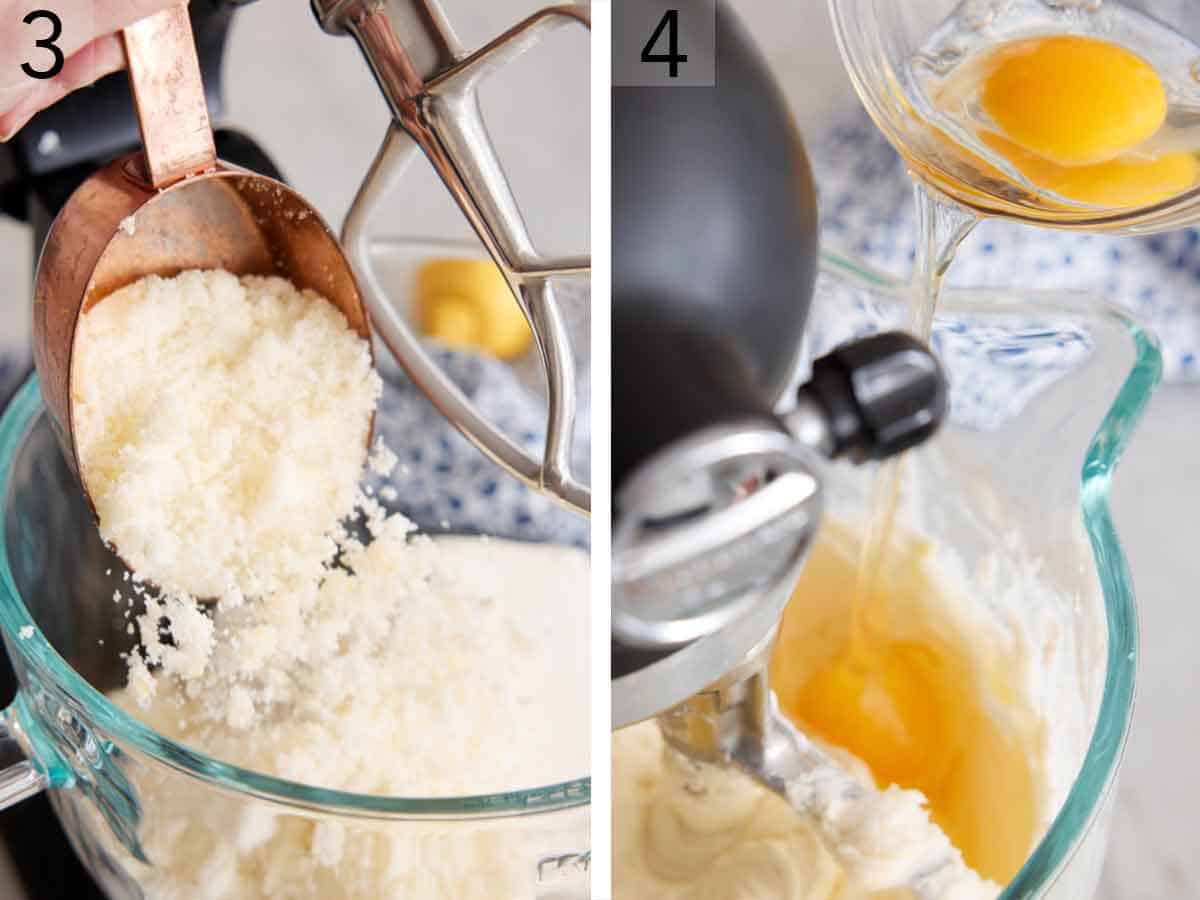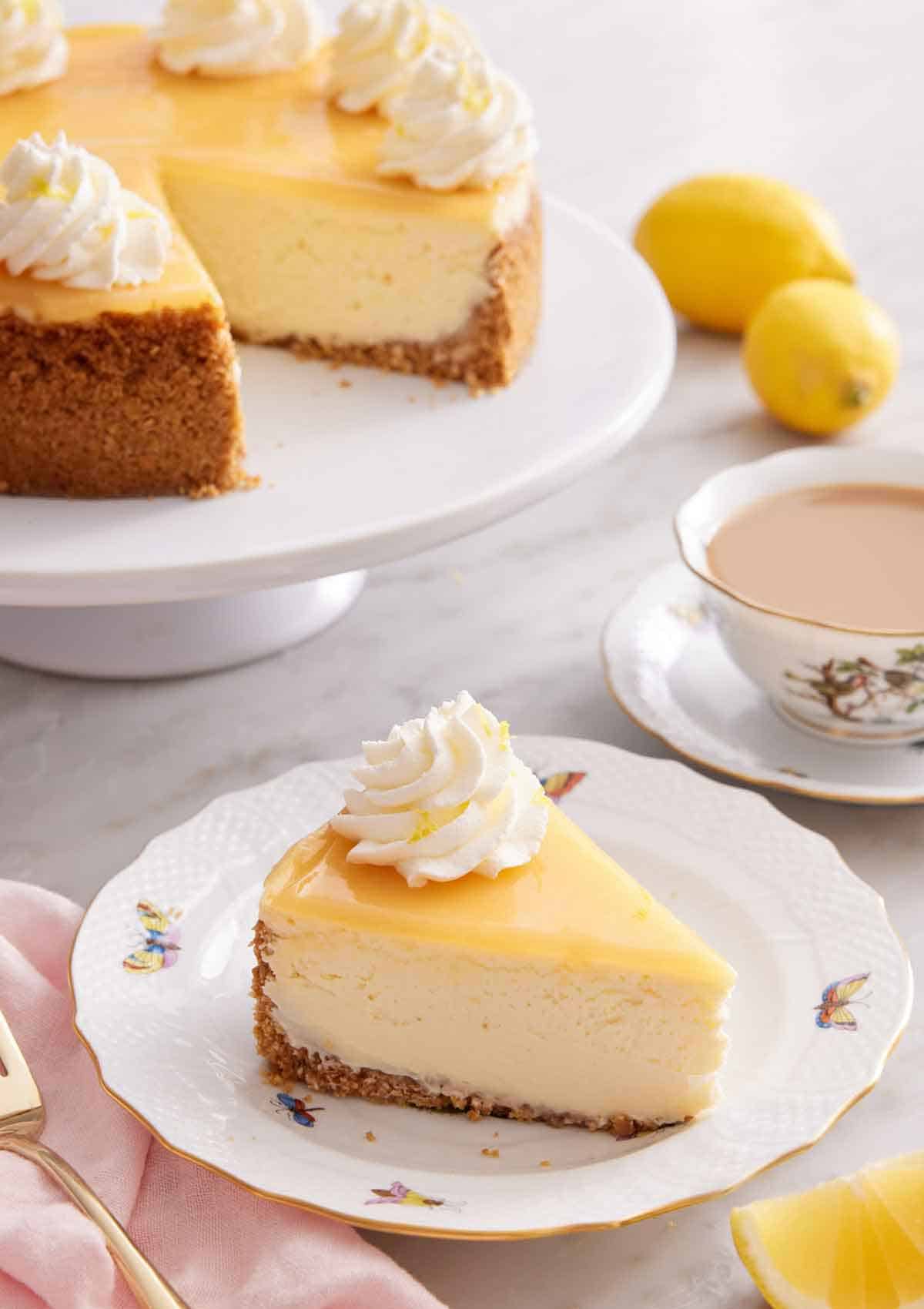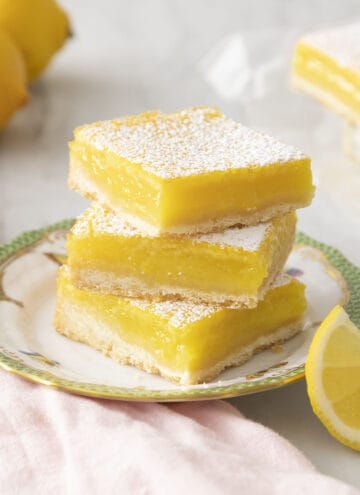This lemon cheesecake recipe is full of lemon flavor and will practically melt in your mouth! From the lemon juice and zest in the batter, lemon curd on top, and the lemon zest garnish, this recipe’s bright and sunny flavors won’t disappoint.
Easy to make, super creamy, and with just the right amount of tanginess, this cheesecake is a showstopper. It’s the perfect dessert for anything from holidays to birthday parties and is also excellent when you’re craving a refreshing dessert in the summer. If you want another easy cheesecake recipe, then try my blueberry cheesecake recipe, strawberry cheesecake recipe, or basque cheesecake recipe.
What You Need to Make This Recipe

Graham cracker crumbs — you can buy or make your own graham cracker crumbs with cookies. If you are crushing your graham cracker crumbs, crush them as evenly and small as possible to avoid large chunks in your crust.
Butter — use unsalted butter to prevent the graham cracker crust from tasting salty. It adds a delicious buttery flavor to the crust and holds the crust together.
Lemons — you’ll need lemon zest and lemon juice for this cheesecake. I highly recommend using freshly squeezed lemon juice as the flavor is more bright, flavorful, and tangy.
Cream cheese — I recommend using full-fat cream cheese for the best lemon cheesecake. Do not buy the spreadable type from a tub. To avoid lumpy batter, it’s important to bring the cream cheese to room temperature before using it.
Eggs — eggs are important in helping the cheesecake set and giving it structure. It also gives the filling its rich texture.
Heavy cream — heavy cream adds richness and moisture to the cheesecake filling. Do not swap for milk or half-and-half.
Lemon curd — you can use store-bought or homemade lemon curd but I prefer my homemade lemon curd recipe as it’s more flavorful!
How to Make Lemon Cheesecake

1. Combine the graham cracker crumbs, sugar, and melted butter in a food processor and pulse until it’s the texture of wet sand. Press the mixture into a prepared springform pan and press the graham cracker mixture into the bottom and 1-inch up the sides of the pan. Bake for 10 to 15 minutes or until the crust is fragrant and turning golden brown on the edges.
2. In a clean food processor bowl, blend the sugar and lemon zest for about 30 seconds, or until the sugar turns a pale yellow.

3. In a large mixing bowl or the bowl of a stand mixer fitted with a paddle attachment, beat the cream cheese, salt, and lemon-sugar on medium-high until smooth.
4. Reduce the speed to medium-low. Add the eggs one at a time, beating until each is well combined before adding the next one.

5. Add the vanilla, heavy cream, and lemon juice and beat until combined.
6. Pour the filling into the cooled crust and place the pan in a large roasting pan.

7. Place the roasting pan in the oven and pour boiling water about halfway up the sides of the springform pan, making sure it doesn’t go above the foil. Bake for 50 minutes or until the filling is puffed and jiggles slightly when gently shaken. Turn off the oven and prop open the oven door, letting the cake cool inside the oven for 1 hour. Then chill the cake for 4 hours or overnight.
8. When ready to serve, spread the lemon curd evenly over the top of the lemon cheesecake. Pipe with whipped cream and garnish with fresh lemon slices or zest, if desired.

Pro Tips for Making This Recipe
- If you don’t have a food processor, then you can mix the crust together in a bowl with a spatula or your hands. Just make sure the butter is well distributed. For the lemon-sugar, combine the sugar and zest in a bowl and rub the mixture with your fingers until the sugar is very fragrant and feels damp.
- For the best results in your lemon cheesecake, add the eggs one at a time so it evenly incorporates into the batter. Make sure to use eggs that have been left at room temperature before using them as it’ll mix into the batter better. If your eggs are cold, place them in a bowl of warm water for a few minutes. This method will help to quickly bring them to room temperature if you have forgotten to take them out of your fridge beforehand.
- Do not overmix the cheesecake batter, as it will introduce too much air to the filling. Air in the batter leads to the cheesecake rising more in the oven and then collapsing, leaving cracks.
- When you pour the cheesecake batter into the pan, gently tap the pan on the counter to pop any air bubbles in the batter.
- Let the cheesecake cool gradually at room temperature before transferring it to the fridge. If you add the cold cheesecake directly into the refrigerator to cool, it’ll crack.
- Use wide heavy-duty foil if possible. You want to ensure you fully wrap the springform pan to avoid leaks from the water bath into your cheesecake.
- Keep the oven door closed! Don’t be tempted to open the oven door to peek at the cheesecake while it bakes. The hot air from the oven will escape, and cold air will enter the oven, causing the lemon cheesecake to fall or crack.
- When zesting a lemon, stop zesting once you reach the white layer, as it’s bitter.

Frequently Asked Questions
If you want to avoid cracks on your cheesecake, be careful not to overmix the batter or mix it too quickly. This can cause air bubbles to form and rise to the surface or cause the cheesecake to rise too much and then deflate and crack. Also, it’s best to use ingredients that are at room temperature to ensure they combine easily and to stop mixing as soon as they are just incorporated. But don’t worry too much if your cheesecake does crack because it’ll still be just as delicious and you can always cover it up with the lemon curd!
You can make this lemon cheesecake ahead of time as it does take time to chill and set in the fridge. This cheesecake can be refrigerated and covered for up to 4 days. It’s best to keep it covered in the fridge so it does not take on any scents from the refrigerator. Hold off on adding the whipped cream until ready to serve.
Yes, you can freeze cheesecake! Wrap the entire cheesecake or individual slices in both plastic wrap and foil and freeze for up to 3 months. I recommend freezing the cheesecake without the lemon curd and garnishes and then topping the cheesecake before serving.
If you’ve tried this Lemon Cheesecake recipe, then don’t forget to rate the recipe and let me know how you got on in the comments below, I love hearing from you!

Lemon Cheesecake
Video
Equipment
- Food Processor
- 9 inch springform pan
- Electric hand or stand mixer
- Mixing Bowls
- Roasting pan
- Foil
Ingredients
For the Crust:
- 2¼ cups graham cracker crumbs (270g)
- 3 tablespoons granulated sugar
- 6 tablespoons unsalted butter melted (84g)
For the Filling:
- 1¼ cup granulated sugar (250g)
- 2 tablespoons lemon zest packed (10g)
- 4 packages cream cheese room temperature (8-ounce/227g)
- 3 large eggs room temperature
- ½ teaspoon vanilla extract
- ¼ teaspoon salt
- ⅓ cup heavy cream room temperature (80ml)
- ¼ cup lemon juice (60ml)
- ½ cup prepared lemon curd (174g)
- Whipped cream
- Lemon slices or zest
Instructions
For the Crust:
- Preheat the oven to 350 F. Wrap the outside bottom of a 9-inch springform pan in two layers of aluminum foil. Lightly grease the inside with baking spray with flour.
- In the bowl of a food processor, combine the graham cracker crumbs and sugar. Pulse a few times to combine. Add the melted butter and pulse until the mixture feels like wet sand. Transfer the mixture to the prepared pan. Using the bottom of a glass or measuring cup, press the graham cracker mixture into the bottom and 1-inch up the sides of the pan. Place the pan on a rimmed baking sheet.
- Bake for 10 to 15 minutes or until the crust is fragrant and turning golden brown on the edges. Let cool completely.
For the Filling:
- Reduce the oven temperature to 325F.
- In a clean food processor bowl, blend the sugar and lemon zest for about 30 seconds, or until the sugar turns a pale yellow.
- In a large mixing bowl or the bowl of a stand mixer fitted with a paddle attachment, beat the cream cheese, salt, and lemon-sugar on medium-high until smooth, about 2 minutes, stopping to scrape down the sides a few times during mixing.
- Reduce the speed to medium-low. Add the eggs one at a time, beating until each is well combined before adding the next one. Stop and scrape down the bowl occasionally. Add the vanilla, heavy cream, and lemon juice and beat until combined. Pour the filling into the cooled crust and place the pan in a large roasting pan.
- Place the roasting pan in the oven and pour boiling water about halfway up the sides of the springform pan, making sure it doesn’t go above the foil.
- Bake for 50 minutes or until the filling is puffed and jiggles slightly when gently shaken.
- Turn off the oven and prop open the oven door with a wooden spoon, letting the cake cool inside the oven for 1 hour. Remove the springform pan from the roasting pan and chill the cake for 4 hours or overnight.
- When ready to serve, spread the lemon curd evenly over the top of cake. Pipe with whipped cream and garnish with fresh lemon slices or zest, if desired.
Notes
- If you don’t have a food processor, you can mix the crust together in a bowl with a spatula or your hands. Just make sure the butter is well distributed. For the lemon-sugar, combine the sugar and zest in a bowl and rub the mixture with your fingers until the sugar is very fragrant and feels damp.
- For the best results, add the eggs one at a time so it evenly incorporates into the batter. Make sure to use eggs that have been left at room temperature before using them as it’ll mix into the batter better. If your eggs are cold, place them in a bowl of warm water for a few minutes. This method will help to quickly bring them to room temperature if you have forgotten to take them out of your fridge beforehand.
- Do not overmix the cheesecake batter, as it will introduce too much air to the filling. Air in the batter leads to the cheesecake rising more in the oven and then collapsing, leaving cracks.
- When you pour the cheesecake batter into the pan, gently tap the pan on the counter to pop any air bubbles in the batter.
- Let the cheesecake cool gradually at room temperature before transferring it to the fridge. If you add the cold cheesecake directly into the refrigerator to cool, it’ll crack.
- Use wide heavy-duty foil if possible. You want to ensure you fully wrap the springform pan to avoid leaks from the water bath into your cheesecake.
- Keep the oven door closed! Don’t be tempted to open the oven door to peek at the cheesecake while it bakes. The hot air from the oven will escape, and cold air will enter the oven, causing the cheesecake to fall or crack.
- When zesting a lemon, stop zesting once you reach the white layer, as it’s bitter.














